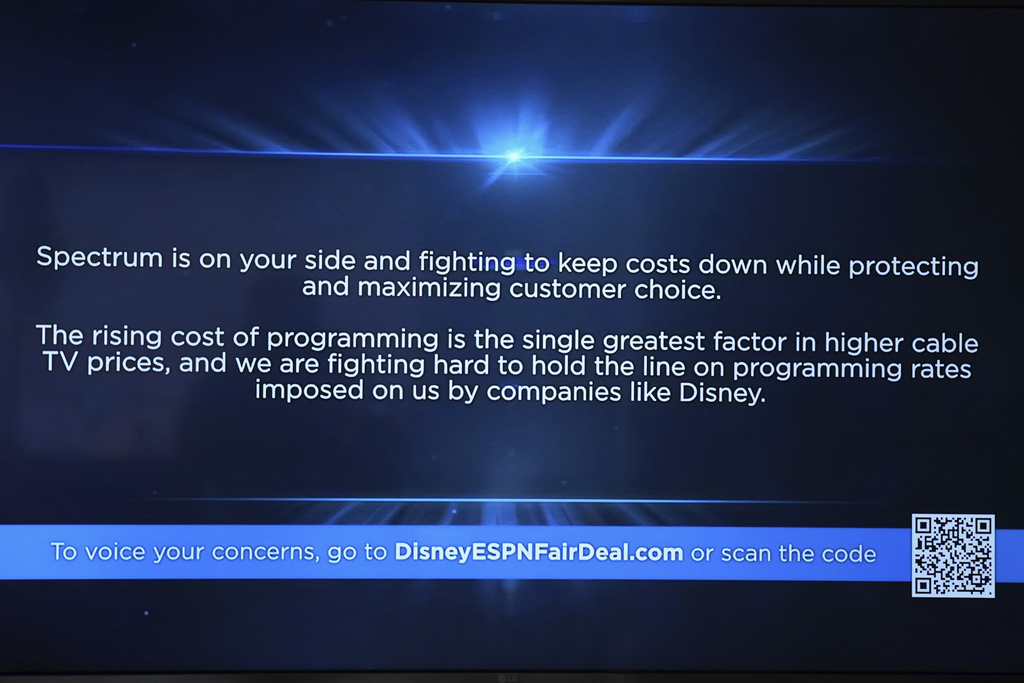Like most fans of televised sports, this weekend I learned of the ongoing battle between Disney and Charter while trying to tune into the US Open.
Instead of top international tennis player dashing around the classic blue and green courts, I was greeted by a custom message from Charter’s Spectrum cable about how ESPN’s parent company, Disney, was seeking more money from the cable provider and, therefore, not currently available.

Kirby Lee via AP Photos
Of course, Disney tells a different story and appears to have even encouraged talent to tell viewers to find their programming on streaming giant Hulu, which it owns a majority stake of. Consider this tweet from Stephen A. Smith:
This isn’t the first spat between a carriage provider and a content provider, so I didn’t think much of it at first blush. But this feels different than DirectTV battling with a single network. Disney, arguably the most significant media outlet, standing firm on costs/revenue with one of the larger cable providers. As Sara Fischer and Tim Baysinger posit on Axios, the Disney-Charter fight could start the TV bundle breaking.
It’s an insightful piece that opens with:
The financial dispute between Disney and Charter highlights the growing tensions between content providers and cable and satellite operators as cord-cutting threatens to permanently unravel the cable TV business.
Why it matters: If this fight isn’t resolved, the entire business model for the traditional cable TV industry could be on the verge of collapsing.
We live in a world of cord-cutters — at this point, it’s not just Millennials or Gen Z who are unaccustomed to linear cable boxes. I can count dozens of Generation X pals who have also foregone cable boxes for Amazon Prime Live TV or YouTube TV. Every month, when I look at my massive cable bill, I get closer to doing the same.
I know other linear addicts who have long considered cutting out cable. Not being able to watch ESPN or, in my small sample group, college football on ABC was enough for many to literally pull the plug. And if that is an indication of the start of a much larger trend, that tipping point could spell doom for the entire revenue model built on cable provider subscription fees. And Disney, ABC, ESPN et al all leaving a cable model in lieu of their own revenue or subscription model? It doesn’t take a genius to see how the entire house of cards could begin to collapse.
The current content provider cable subscription model does feel outdated. The shared experience that comes with watching linear television feels much closer to the rotary phone era than it does to texting a friend or loved one on a smartphone. The traditional model is collapsing before our eyes. The only question is how long does it last: months, years, or decades? I’d guess that by the 2028 presidential election, fewer political ads will be placed on linear television than on digital outlets.
None of this is new to anyone who has been paying attention. Still, this gradual evolution of media presents a severe and existential threat to the cable news industry, which is cause for serious alarm.
While the cable news business is showing signs of decline, it remains a lucrative business model, in large part due to the substantial revenue networks receive as part of carriage fees from cable providers. For example, while critics point to CNN’s steady decline in ratings and ad revenue, the vast majority of its total revenue comes from cable subscription fees — making the outlet a remarkably profitable one, even in times of bad ratings.
MSNBC and Fox News benefit similarly from the economics of the business, making them somewhat impervious to ad recessions or ratings downturns. But the model also has its downsides, particularly when it comes to the effort from cable news companies to venture out into the world of streaming. The agreements signed between cable news networks and carriage companies insist that the linear product that shows up on Comcast, Cox, and Spectrum boxes, for example, cannot show up as a streaming product.
One of the chief reasons CNN+ was never going to succeed is that CNN+ didn’t offer the premium CNN product you get on the cable box. Fox News’s streaming platform Fox Nation has proven to be a prescient and successful lifestyle subscription product, but it doesn’t offer the Fox News that viewers know from cable. It’s primarily composed of complementary programs featuring Fox News personalities.
So, these cable news networks are contractually bound not to provide their linear product via a stream. When the cable carriage ecosystem collapses as cord-cutting accelerates, the jump to streaming will become even more daunting a move.
Paul Farhi neatly explained the scary scenario for cable newsers in the Washington Post, writing:
During the first quarter of 2023, another 2.3 million customers (or 7 percent of the total) cut the cord to traditional cable — the fastest cancel-my-subscription pace ever recorded, according to MoffettNathanson, another research firm. The company estimates the number of homes receiving TV via cable is now about the same as it was in 1992, when the industry was still on the rise.
“Cable news is dying,” wrote Alan Wolk, a veteran advertising executive and media consultant, in a recent newsletter about the TV industry. “Not because it’s become irrelevant, but because the medium it lives on, cable TV, is dying.” He predicts that cable could, “for all intents and purposes, disappear” within a decade.
The advent of coaxial copper connections turned TV news from a once-or-twice a day ritual to something more like a lifestyle for millions of people drawn by the urgency of breaking stories and political commentary on a 24-hour cycle.
The current battle between Disney and Charter puts a dire situation in even starker relief.
The cable news industry directly employs thousands of journalists. The support and secondary industries employ tens of thousands more people. So this is a warning for everyone whose paycheck comes from those industries. Live video news will forever be in demand, but the suppliers of that kind of news are about to transform dramatically.
And it’s not clear that anyone has entirely thought this through.
This is an opinion piece. The views expressed in this article are those of just the author.






